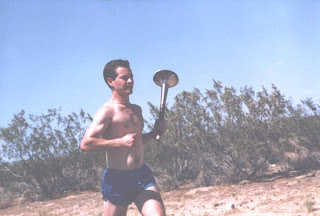Runnin' on Empty
 During Peace Run '89, I saw and felt so much. I wish I had kept a journal.
During Peace Run '89, I saw and felt so much. I wish I had kept a journal.Over the next three and a half months, I'd touch foot in each of the 48 contiguous United States, average about 10 miles a day of running, enjoy wondrous highs, and suffer frustrating lows. My time on the Peace Run was an invaluable experience on every level which would ease my eventual transition from the Center to civilian life.
The course we embarked on took us south and then west on a serpentine course designed both to touch major population centers and to cross into each nearby state along the way. The runners, generally, were divided first by the sexes -- there was a boys' team and a girls' team -- and then again by either morning or afternoon crews. Arpan was the overall leader on the ground and for at least the first month or so a middle-aged woman disciple played den-mother for the girls' team.
Throughout the summer, there were typically about a dozen runners -- guys and girls combined -- on the run at any one time. About six of us were on the run from beginning to end, while the rest of the team members were made up by disciples who would meet up with the run for varying lengths of time, sometimes a week or two, sometimes a month or two. As a whole, we typically covered more than a hundred miles a day in relay fashion. Thus, when there were fewer disciples supplementing our core group of runners, we had to run further each day (and vice versa).
Oftentimes, members of the the public also helped. One of my favorite of these moments was having a small group of Navajo teenagers pull up alongside us in either Arizona or New Mexico as we ran through their territory. Part of a fledgling cross-country team, they took turns clicking off the miles in that barren, magical landscape, holding the peace torch with a reverence that I had long since traded for familiarity.
As runners, we were just the most visible part of the Peace Run. Coordination of the run's public relations events -- ceremonies and press contacts -- were coordinated by Shambhu and his assistants in New York. One young woman who deserves special praise is Lahiri. Originally hailing from the Chicago Center, Lahiri had moved to New York at more or less the same time I had. Behind the scenes, she (and I expect others unknown to me) worked tirelessly to arrange lodging for the runners at hotels along our route each night. Thanks to her effort, we spent 85% of our nights sleeping in hotel rooms rather than camping at KOA camps or RV parks. That made all the difference in the world to me, and was critical to my already shaky morale.
I did find the run liberating, if only because I was out of the city. I was out on the road, running big mileage, and breathing fresh air everyday. But even on the Peace Run, I couldn't completely escape the annoying scrutiny of some eager beaver disciples.
For example, I loved to run shirtless (as you can see in the photo above). This drove the girls' team leader -- a middle-aged mom comfortable ordering boys around -- crazy. She confronted me about it and "asked" me to wear a Peace Run shirt whenever I was running. I ignored her. The next time she saw me running shirtless, she complained to Arpan and threatened to call New York (i.e., complain to Guru about it). Arpan was sympathetic to me. I only took my shirt off in the countryside, but I was making his already difficult job even harder. So, I kept my shirt on (unless it got really hot!).
In any event, I had no intention of breaking any of Guru's rules. And, as an important aside, I was still "master of my domain!"



Comments